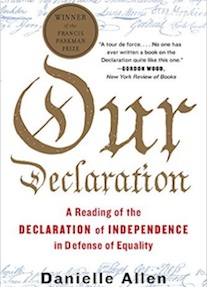Shortlisted for the 2015 ΦBK Ralph Waldo Emerson Award
By D.T. Siebert
In Our Declaration: A Reading of the Declaration of Independence in Defense of Liberty (Liveright, 2014), Danielle Allen closely analyzes not only the rhetoric and argumentative structure of The Declaration of Independence (1776), but also its individual word choices, capitalization, and punctuation. Allen’s goal is to show that the Declaration speaks for all Americans, indeed for all people, and not just for propertied white men of the late18th century. Are the concepts of liberty and equality in opposition, or conjoined? What indeed can the assertion that “all men are created equal” mean, especially coming from the pen of Thomas Jefferson, a slave owner? That the author is herself the daughter of an African-American father and a “WASP” (as she puts it) mother gives these questions a special poignance.
Allen reminds us that the Declaration was not the sole creation of Jefferson but rather the product of a committee. Jefferson simply wrote the essential first draft. The Declaration is a product of many revisions. Even its parchment calligrapher and printer influenced the document’s meaning by their choices of capitalization and punctuation. In one case a printer’s use of a period instead of a comma interrupts the argument’s logical flow. Allen remarks, “This affair of the errant period is no trivial matter, no arid scholastic debate about angels on the heads of pins.” Quite so, and that is close reading at its best.
The central question is what to make of the phrase “all men are created equal”—equal, that is, “in the rights of life, liberty, and the pursuit of happiness.” Allen argues that “all men” eventually came to mean exactly that, even though some who signed the Declaration may not have had African slaves and American Indians in mind. What many believed then was a reality of the times, reflecting habits and values now seen as intolerable. Jefferson and others had a vested self-interest in the institution of slavery, and it was also part of a way of life taken almost for granted. Also, it was not uncommon to believe that certain “races” were inferior or even sub-human. One sees that view, for example, in the Scottish William Robertson’s History of America (1777).
Still, as Allen argues, the claim that “all men are created equal” gradually ushered in the abolition of slavery in the Northern states and the voluntary freeing of slaves by some of their owners. Very telling is that the vice-president of the Confederacy would write “that the original American Union rested upon the assumption of the equality of races . . . . Our new government is founded upon exactly the opposite: that the negro is not equal to the white man.” Allen concludes, “[Those who] launched the Civil War thought that . . . the phrase all men are created equal, did pertain to everyone,” and they were intent on denying the assertion. In any case, history has proven the unambiguous truth of the Declaration’s noble words.
As Allen tells us, this book’s genesis was in a night-school course, which suggests much of the book’s rhetorical strength, and something of its weakness. The book has an engaging conversational style and a passionate dynamic. Yet, there is a tendency to over-explain, sometimes with information, metaphors, and analogies more suitable for beginning undergraduates than for the presumed audience of this book.
Overall, however, Allen shows just how much a close reading of 1,337 words can yield. The book’s inclusion of early printed material adds graphic evidence to Allen’s points—for example, a broadside offering rewards for killing “savages” and one advertising “prime, healthy Negroes” for sale in Charleston. A brief review cannot do justice to this book’s insights and its convincing reminder of this document’s greatness.
D.T. Siebert (ΦBK, University of Oklahoma, 1962) is Distinguished Professor Emeritus of English Literature, University of South Carolina, Columbia. His recent book Mortality’s Muse: The Fine Art of Dying, was reviewed in The Key Reporter in 2014.




